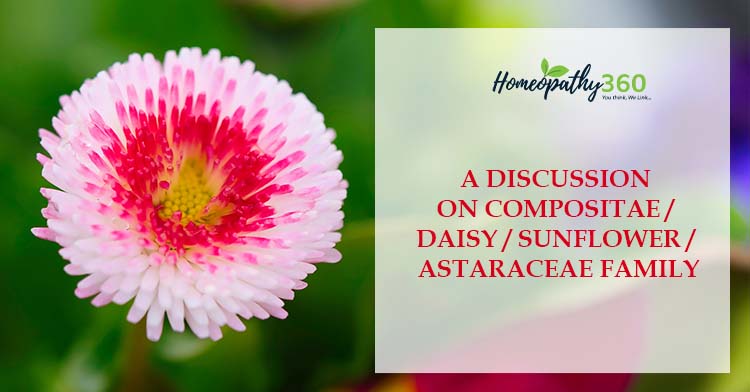
Abstract: Compositae family is one of the largest groups in our homoeopathic materia medica and the medicines are grouped like; injury group, convulsion group, fever group, GIT (gastrointestinal) group and other medicines. It has wonderful healing properties after any type injury, ailments after physical injury as well as covers the injury to emotional level. Affinity for the blood and blood vessels related conditions like, bruising, bleedings, etc. It has curative actions over infectious diseases, female reproductive organs and excellent remedy for fever.
Key-words: Compositae family, common name, pharmacy, constitution, clinical.
Abbreviations: GIT – gastrointestinal.
Introduction:
Leaves are alternate opposite, radical simple or compound. Uniqueness of family is what appears to be a single flower is actuallycomposite of many small florets. Hence the name of this family is compositae.
All plants are characterised by strong aromatic odor either pleasant or pungent. Bitterness is the prevailing characteristic of these plants, which compose the order.
This family has wide spectrum of homoeopathic remedies that can be divided into three groups:
- Convulsion group of remedies: In these remedies, there is deficiency of nutrition, causing emaciation though the patient eats. Problems of nursing mothers, lot of behavioural disturbances.
- Injury group of remedies: In this group there is profuse and easy bleeding, soreness. This group shows extreme fear and fright, accidental dreams.
- GIT, GUT and Fever group of remedies: This group affects ciliac ganglia leading to various complaints related to intestine, kidneys, spleen, liver, etc.
Active principles
Hydrocarbons, alcohols, phenolic ester, acetone, acids, esters, sugars, starch, resinoid, glucosides, alkaloids.
Ailments from
Mechanical injury and wounds fall from height, over-exertion, lifting, shock, being chilled or over-heated, repeated trauma, blood poisoning, suppression of discharges, grief and bad news, fright and suppression of anger.
Sphere of Action
Capillaries. muscle and soft connective tissues. Mucous membrane of GIT, respiratory system, GUT. Mind. Nerves. Blood. Skin. Internal organs. Glands-Breast. Female Reproductive system. Joints.
Clinical conditions
Wounds and trauma, mechanical injury, chronic cough, bronchitis, hysteria, sedatives effect, nephritis, uremic, menstrual disorders, rheumatic pains, intermittent fever, sciatica, convulsions, worms infestations, neuralgias, diarrhoea, marasmus, gangrene, tumors and recurrent boils.1
Common name, pharmacy and constitutions of common medicines belong to compositae family compiled from Lotus Materia Medica by Robin Murphy.
1. Abrotanum. (Artemisia abrotanum)
Common Name: Southernwood. Lady’s love.
Pharmacy: Tincture of fresh leaves and stems.
Constitutions: Suited to disorders of new born children, especially boys. Children with emaciation, especially legs. Marasmus. Digestive weakness in the elderly.
2. Absinthium. (Artemisia absinthium)
Common Name: Common Wormwood.
Pharmacy: Tincture of fresh young leaves and flowers.
Constitutions: Younger and elderly patients. Chlorosis.
3. Millefolium achillea
Common Name: Yarrow.
Pharmacy: Tincture of the fresh plant.
Constitutions: Suited to the aged, atonic, anaemic women and children.
4. Arnica montana
Common Name: Leopard’s Bane.
Pharmacy: Tincture of whole fresh plant.
Constitutions: Adapted to sanguine, plethoric persons, disposed to cerebral congestion. Persons easily made train-sick or seasick. It is suited to persons who are sensitive to mechanical injuries and who feel the effects of them long after. Teste noted it for plethoric red-faced persons.
5. Artemisia vulgaris
Common Name: Mugwort. Wornwood.
Pharmacy: Tincture of fresh root.
Constitution: It has a prominent place in convulsive diseases of childhood and girls at puberty.
6. Bellis perennis
Common Name: English daisy.
Pharmacy: Tincture of whole fresh flowering plant.
Constitution: Suited to old gardeners, farmers, laborers and commercial travellers. Carbo-fluorica types with tendency to visceral ptosis, laxity of the ligaments and haemorrhages.
7. Calendula officinalis
Common Name: Pot Marigold.
Pharmacy: Tincture of leaves and flowers.
Constitution: Constitutional tendency to erysipelas.
8. Carduus marianus
Common Name: St. Mary’s Thistle. Silybum marianus.
Pharmacy: Tincture or trituration of seeds.
Constitution: Choleric constitutions.
9. Chamomilla.
Common Name: German Chamomile. Marticaria chamomile.
Pharmacy: Tincture of whole plant.
Constitution: Suited to diseases of pregnant women, nurses and little children. Irritable, colicky babies, teething problems, earaches. Hypersensitive to pain. Arthritic diathesis. Neuralgic or gouty rheumatic diathesis.
10. Cina maritima
Common Name: Wormseed. Cina artemisia.
Pharmacy: Tincture. Cina maritima is the source of the alkaloid Santonin.
Constitution: Generally hungry, cross, ugly, and wants to be rocked. Children who are big, fat, rosy and scrofulous, they stiffen out, when looked at, during cough or when they become cross.
11. Echinacea angustifolia.
Common Name: Purple Cone-flower.
Pharmacy: Tincture of whole fresh plant.
Constitution: Broken-down and weak constitutions.
12. Eupatorium perfoliatum.
Common Name: Bone-set. Thoroughwort.
Pharmacy: Tincture of whole plant.
Constitutions: Worn-out constitutions from inebriety.
13. Senecio aureus
Common Name: Golden Ragwort. Squaw-weed.
Pharmacy: Tincture of fresh plant in flower.
Constitutions: Suited to women and little girls of nervous temperament.
14. Solidago virgaurea
Common Name: Goldenrod. Tincture of fresh plant.
Pharmacy: Tincture of fresh flowers. The fresh blossoms are macerated in twice their weight of alcohol. Infusion of dry leaves and flowers.
Constitutions: Especially suited to scrofulous subjects.
Common Name, Pharmacy and Clinical Indications of Rare Medicines under Compositae Family compiled from Lotus Materia Medica by Robin Murphy.
1. Brachyglottis repens
Common Name: Puka Puka.
Pharmacy: Tincture of green leaves and flowers.
Clinical: Kidney and bladder symptoms predominate. Albuminuria, Back pain, Bright’s disase. Cystitis, Dysmenorrhoea, Nephritis, Writer’s cramp.
2. Cardus Benedictus
Common Name: Blessed Thistle. Cincus Benedictus.
Pharmacy: Tincture of whole plant when flower.
Clinical: Amaurosis. Asphyxia. Coma. Diarrhoea. Dysphagia. Stricture.
3. Cichorium intybus
Common Name: Chicory.
Pharmacy: Tincture or trituration of dried root.
Clinical: Amblyopia, Constipation, Fatigue, Headaches.
4. Cineraria maritima
Common Name: Dusty Miller.
Pharmacy: Tincture or succus of the fresh plant, growing wild, gathered just before the flower-buds open.
Clinical: Cataract, Corneal opacity, Eye injuries.
5. Echinacea purpurea
Common Name: Black Sampson.
Pharmacy: Tincture of fresh root.
Clinical: Boils, Carbuncles, Diphtheria, Fatigue, Furuncles, Impetigo, Putrid fevers, Pyaemia, Scarlatina, Septicaemia, Suppuration, Vaccination effects, Wounds.
6. Erigeron canadensis
Common Name: Fleabane. Leptilon canadense.
Pharmacy: Tincture from fresh plant when bloom.
Clinical: Haemorrhagic remedy, especially when haemorrhages are profuse, bright red, gushing.
7. Eupatorium aromaticum.
Common Name: White Snake-root. Deer-wort.
Pharmacy: Tincture of root.
Clinical: Ague, Apthae, Chorea, Gravel, Hysteria, Neurasthenia, Sore, Nipples, Stomatitis, Vomiting.
8. Eupatorium purpureum
Common Name: Gravel Root. Quen of the meadow. Joe Pye weed. Trumpet weed.
Pharmacy: Tincture of the root.
Clinical: Albuminuria, Bedwetting, Bladder irritable, Chills, Cystitis, Diabetes insipidus, Dropsy, Dyspnoea, Dysuria, Enlarged prostate, Fever, Gravel, Headache, Hematuria, Homesickness, Hysteria, Impotency, Infertility, Urine retention.
9. Gnaphalium polycephalum
Common Name: Cud-wed. Old balsam.
Pharmacy: Tincture of fresh plant.
Clinical: Used mainly in disorders of the sciatic nerve. It also has action on the abdominal organs, causing vomiting, colic, and diarrhoea.
10. Grindelia robusta
Common Name: Rosin-wood.
Pharmacy: Tincture is made of the leaves and unexpanded flowers.
Clinical: Asthma, Bites, Blisters, Bronchitis, Burns, Cheyne-Stokes, Conjunctivitis, Emphysema, Erythema, Fleabites, Glaucoma, Heart disorders, Herpes zoster, Hyperchlorhydria, Iritis, Itching, Liver pain, Lung disorders, Ophthalmia, Rheumatism, Rhus poisoning, Pruritus, Skin disorders, Spleen disorders.
11. Guaco
Common Name: Climbing Hemp Weed. Mikania guaco.
Pharmacy: Tincture and decoction of leaves.
Clinical: Acts on the nervous system and female organs. Bulbar paralysis. Spinal irritation. Syphilis. Cancer. Dirrhoea and dysentery withaching in sacrum and loins. Phosphaturia.
12. Helianthus annus
Common Name: Sunflower.
Pharmacy: Tincture of mature flower-heads. Tincture of ripe seeds.
Clinical: Spleen disorders, Chronic cases of intermittent fever, Coryza, Catarrh, Nasal harmorrhage and thick scabs in nose, Rheumatic pain, Urticaria.
13. Inula helenium
Common Name: Scabwort. Elecampane.
Pharmacy: Tincture of fresh root dug in autumn of the second year.
Clinical: Bachache. Bronchitis. Cough. Cramp. Diabetes. Dyspepsia. Dysmenorrhoea. Dry cough. Erysipelas. Leucorrhoea. Sciatica. Toothache.
14. Lactuca virosa
Common Name: Acrid Lettuce. Poison lettuce.
Pharmacy: Tincture of fresh flowering plant.
Clinical: A true galactagogue, as it increases the milk in breast. Also acts upon the brain and circulatory system. Delirium tremens with sleeplessness, coldness and tremor. Hydrothorax and ascites.
15. Lapsana communis
Common Name: Nipple-wort.
Pharmacy: Tincture of infusion of whole fresh plant.
Clinical: Haemorrhoids, Nipple sore.
16. Liatris Spicata
Common Name: Colic-root. Dense button-snakeroot. Gay feather. Devil’s bit.
Pharmacy: Tincture of powdered fresh root.
Clinical: Anasarca, colic, Diarrhoea, Dropsy, Headache, Indigestion, Kidney dropsy, Ulcers.
17. Parthenium hysterophorus.
Common Name: Bitter-broom. Congress grass. Escobaamargo.
Pharmacy: The dry plant is macerated in five parts by weight of alcohol.Trituration of solution of the alkaloid Parthenia.
Clinical: Amenorrhoea, Chyne-Stokes breathing, Debility, Dyspepsia, Ear disorders, Fainting, Fevers, Headache, Liver pain, Neuralgia, Periodic salivation, Spleen disorders, Vision disorders.
18. Pyrethrum parthenium.
Common Name: Feverfew. Chrysanthemum parthenium. Anacyclus officinarum.
Pharmacy: Tincture of fresh plant. Tincture of dried roots.
Clinical: Convulsions, Delirium, Diarrhoea, Dysentery, Fevers, Loquacity, Rheumatism.
19. Senecio jacoboea
Common Name: St.James Wort.
Pharmacy: Tincture of fresh plant.
Clinical: Arthritis, Brain disorders, Cerebrospinal, Irritation, Depression, Bedwetting, Headaches, Twitchings, Ulcers.
20. Tanacetum vulgare
Common Name: Tansy. Chrysanthemum vulgare.
Pharmacy: Tincture of fresh plant in flower.
Clinical: Tanac. Has an action on the female generative organs. Use as a vermifuge and has a reputation as a remedy for hydrophobia.
21. Taraxacum officinale
Common Name: Dandelion.
Pharmacy: The tincture from the wholo plant when in flower.
Clinical: Affinity for the liver and bladder. A bilious remedy. Pains in both splenic and liver regions. Ague, Bilious, Cancerous conditions, Debility, Diabetes, Flatulence, Gallstones, Headaches, Hepatitis, Jaundice, Liver disorders,
22. Tussilago farfara.
Common Name: Coltsfoot. British herb. Farfara. Tobacco waste.
Pharmacy: Tincture of fresh plant.
Clinical: Coughs, Gonorrhea, Scrofula, Tuberculosis.
23. Tussilago fragrans.
Common Name: Petasites fragrans. Italian tussilage. Fragrant Tussilage.
Pharmacy: Tincture of the whole plant.
Clinical: Obesity. Plethora.
24. Tussilago petasites
Common Name: Bitter-burr. Petasites officinalis. Petasites vulgaris.
Pharmacy: Tincture of whole fresh plant.
Clinical: Coughs, Gallbladder, Colic, Gonorrhoea, Headache, Lumbago, Prostatitis, Pylorus disorders,
25. Wyethia helenoides
Common Name: Poison Weed. Alarconiahelenioides. Melarhizainuloides.
Pharmacy: Tincture of the root.
Clinical: Allergies, Asthma, Amenorrhoea, Bronchitis, Epiglottis disorders, Fatigue, Hay fevers, Influenza, Itching, Nervousness, Pharyngitis, Post-nasal catarrh, Sneezing, Sore throat, Uvula disorders.2
REFERENCES:
1. Patil JD, Group study in Homoeopathic Materia Medica, B.Jain Publishers, Reprint Edition 2007.
2.Murphy R, Lotus Materia Medica, B.Jain Publishers, Third Indian Edition 2010.
About the authors
- Dr Shweta Patel, BHMS, MD ( Organon of Medicine ), Professor- Department of Homoeopathic Pharmacy, Sumandeep Homoeopathic Medical College & Hospital, SUMANDEEP VIDYAPEETH, Pipariya.
- Dr Srabani Pal, , BHMS, MD ( Repertory ), Professor- Department of Anatomy, Sumandeep Homoeopathic Medical College& Hospital, SUMANDEEP VIDYAPEETH, Pipariya.





